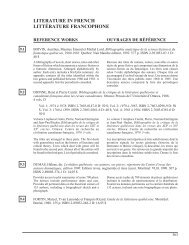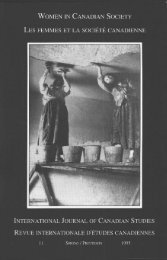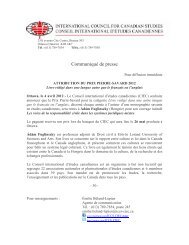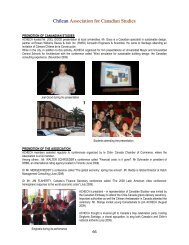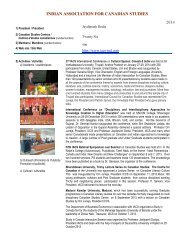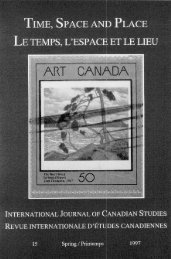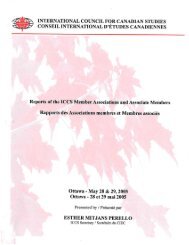Arts and Literature in Canada:Views from Abroad, Les arts et la ...
Arts and Literature in Canada:Views from Abroad, Les arts et la ...
Arts and Literature in Canada:Views from Abroad, Les arts et la ...
- No tags were found...
Create successful ePaper yourself
Turn your PDF publications into a flip-book with our unique Google optimized e-Paper software.
IJCS/RIÉCBibliography of <strong>Canada</strong>’s Major Authors. While Canadian Canons attemptsto document a re<strong>la</strong>tively h<strong>et</strong>erogeneous tradition, deconstruct<strong>in</strong>g rigiddef<strong>in</strong>itions, Lecker argues that even question<strong>in</strong>g canonic values maystrengthen their centrality. At the same time, by <strong>in</strong>clud<strong>in</strong>g essays on bothEnglish-Canadian <strong>and</strong> Québécois literature, the collection advocates dialogue<strong>and</strong> stresses the ways <strong>in</strong> which canons, often reflect<strong>in</strong>g the taste of imperialpowers, dictate a country’s cultural life.The essays open with a discussion of literary histories. Because these oftentransform fragmentation <strong>in</strong>to apparent coherence, actual sectionalism <strong>in</strong>tounity, <strong>and</strong> reliance on the taste of coloniz<strong>in</strong>g powers <strong>in</strong>to authenticnationalism, they need to be questioned, even though such question<strong>in</strong>g may, <strong>in</strong><strong>Canada</strong>, result <strong>in</strong> what Dermot McCarthy calls a permanent “tradition ofcanonic anxi<strong>et</strong>y” (45). Other critics <strong>in</strong>vestigate the marg<strong>in</strong>aliz<strong>in</strong>g effects oftraditionally conservative dom<strong>in</strong>ant paradigms. Carolyn Bayard, <strong>in</strong> “CriticalInst<strong>in</strong>cts <strong>in</strong> Québec,” contrasts English <strong>Canada</strong> <strong>and</strong> Québec, argu<strong>in</strong>g that <strong>in</strong>Québec, criticism is more “historically grounded <strong>in</strong> cultural d<strong>et</strong>erm<strong>in</strong>ants”(125) than it is <strong>in</strong> English <strong>Canada</strong>. In support of her argument, she cites thework of critics as wide-rang<strong>in</strong>g as Casgra<strong>in</strong>, Roy, Nepveu <strong>and</strong> Smart. In“Conflicted Vision,” Donna Benn<strong>et</strong>t describes the ways <strong>in</strong> which what areactually preferences for specific genres (the novel, the short story, po<strong>et</strong>ry ordrama) become evaluative, thus giv<strong>in</strong>g rise to the erroneous belief that valueresides <strong>in</strong> the texts themselves rather than <strong>in</strong> the reader’s perception of them.Benn<strong>et</strong>t’s warn<strong>in</strong>g—not heeded by every contributor to this collection—isexemplified, she tells us, <strong>in</strong> Eastern <strong>Canada</strong>’s glorification of po<strong>et</strong>ry, theWest’s of fiction. “Conflicted Visions” concludes with a question underly<strong>in</strong>gmany of these essays: should canons be established at all? One of the moreperplex<strong>in</strong>g dilemmas fac<strong>in</strong>g post-colonialism is precisely canonization’spotential undercutt<strong>in</strong>g of a literature’s subversive potential. Although, asBenn<strong>et</strong>t suggests, shift<strong>in</strong>g the param<strong>et</strong>ers of value may help national literaturesavoid the k<strong>in</strong>d of conservative rigidity critics comp<strong>la</strong><strong>in</strong>ed about <strong>in</strong> the 1978Calgary Conference on the Canadian Novel, the shifts themselves may leadonly to aimless re<strong>la</strong>tivity.The <strong>la</strong>st two essays illustrate different approaches to contradiction. SheriSimon contrasts Pierre Nepveu’s L’Écologie du réel with Patricia Smart’sÉcrire dans <strong>la</strong> maison du père (published <strong>in</strong> English as Writ<strong>in</strong>g <strong>in</strong> the Father’sHouse), suggest<strong>in</strong>g that Nepveu’s challenge to contemporary Québec’sdef<strong>in</strong><strong>in</strong>g myths is h<strong>et</strong>erogeneous, while Smart’s fem<strong>in</strong>ist response to culturaldef<strong>in</strong>ition is dualistic. Simon uses these differ<strong>in</strong>g approaches to show “how thecultural arena is <strong>in</strong> fact a field of over<strong>la</strong>pp<strong>in</strong>g <strong>and</strong> comp<strong>et</strong><strong>in</strong>g versions ofreality, <strong>and</strong> that power consists precisely <strong>in</strong> the ability to create <strong>and</strong> susta<strong>in</strong>representations <strong>and</strong> their <strong>in</strong>terpr<strong>et</strong>ations” (179). On the other h<strong>and</strong>, <strong>in</strong> the f<strong>in</strong>alessay, Lorra<strong>in</strong>e Weir appears less will<strong>in</strong>g than Simon to accept the idea ofcomp<strong>et</strong><strong>in</strong>g <strong>in</strong>terpr<strong>et</strong>ations or to acknowledge over<strong>la</strong>pp<strong>in</strong>g versions of reality.In a susta<strong>in</strong>ed attack on L<strong>in</strong>da Hutcheon’s work (particu<strong>la</strong>rly The CanadianPostmodern <strong>and</strong> A Po<strong>et</strong>ics of Postmodernism), Weir argues that Hutcheon156



